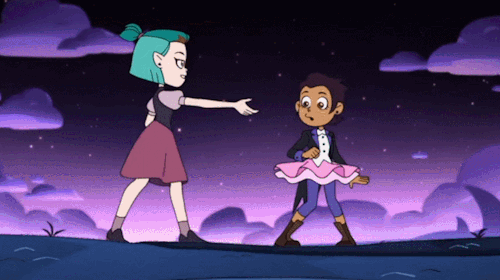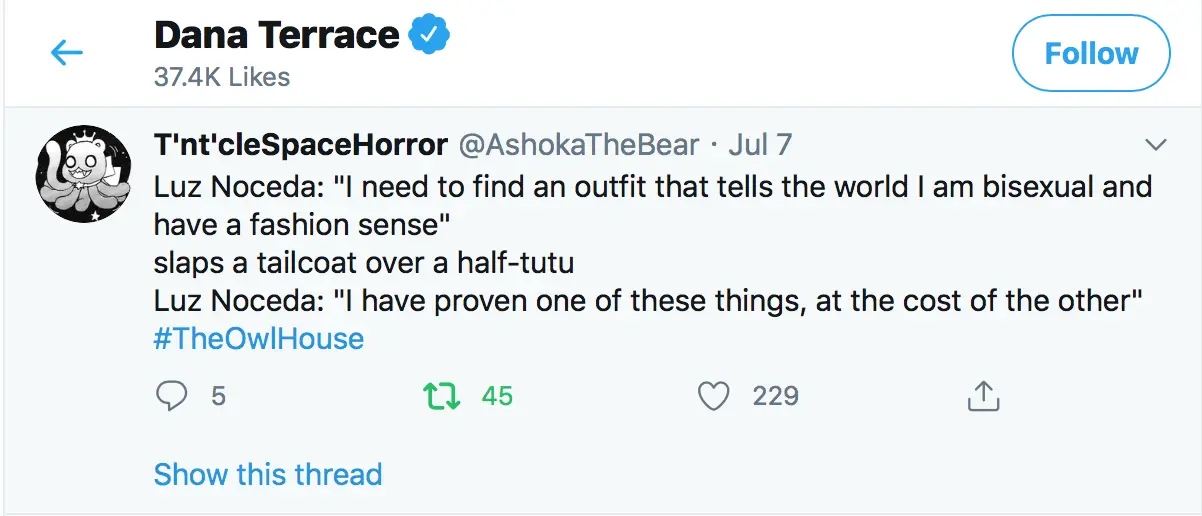Introduction:
With politics and the pandemic still bearing down on us, we are all lost in processing the past, the present, and personhood. The queer community, for example, has seen many celebrities come out. Isolation, idleness, and an unrelenting news cycle has also helped to radicalize people. And for queer people, the movement for acknowledgement and acceptance is shifting towards more material demands. In April, Out.com wrote, “Looks like when people have extra time on their hands, they start really thinking about their lives and their legacies.” That bleeds into how we approach art and what we take from it.
I know that I’ve been thinking about my place in the world, especially as I process my queerness and how it relates to the rest of my life. Recently, I’ve become obsessed with The Owl House, a new Disney cartoon created by Dana Terrace. The show is about a teenage girl, Luz Noceda, who stumbles into a demon realm and apprentices with a witch. Though it just ended its first season, the show is rich in queer subtext for its main character, and Terrace recently confirmed that Luz is bisexual and her love interest a lesbian. The show is affirming for Sapphists who were cheated out of an openly queer, feminist childhood. Sitting with those feelings, turning them over, led me to connect them to my relationship with trauma. The lack of good representation both for trauma survivors and for queer people.
In my last article, I discussed the similarities between trauma-based experiences and the queer ones, focusing on representations of trauma in media. This time I will focus on The Owl House’s queer representation and why the specific prom episode brought up so many emotions for me. Hint: it’s because The Owl House asserts the validity of queer adolescence by using modern and ancient story elements.
( The Owl House also handles themes related to trauma remarkably, but that’s for another article.)
The Owl House is Designed to Feel Familiar:
The Owl House debuted in January, but from its first episode it has the sharp passion of a modern classic. Much like Gravity Falls, the story comes across as self-assured, which is not surprising considering its pedigree. Dana Terrace, an alumni of Gravity Falls and Ducktales, is the creator and showrunner of The Owl House. In a post-Harry-Potter world, even general viewers have caught on to fantasy tropes, and she has designed her show to be the next step in the development of the fantasy genre. The Owl House is an earnest love letter to the fantasy stories we all loved as children, while playfully toying with the tropes.
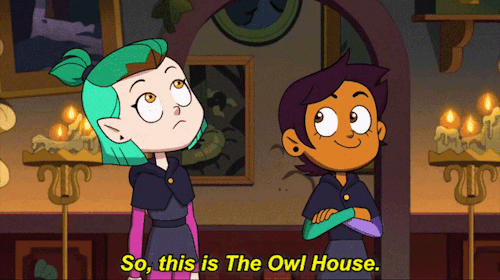
The show is cohesive when it comes to the necessary dialogue between design and character, laying a strong foundation for archetypal narratives. For aesthetic inspiration, Terrace looked to her favorite artists, ranging from European classics to Mexican surrealism. And as one writer noted, “Terrace grew up surrounded by stained glass, Gothic architecture and medieval illuminations. So she turned to illuminated manuscripts and old Christian artists and looked ‘at all the wacky designs they put into their work.’” Such attention to influence and art history means that The Owl House already looks and feels familiar to viewers. It’s a balance between the historically familiar and the modern, recalling her work on Gravity Falls. Medieval artistry meets the animation convention of the late 2010s.
In terms of storytelling, Luz Noceda is the latest in a long line of plucky protagonists — seen in the likes of Robin Hood, Luke Skywalker, and Wonder Woman — driven by deep compassion. She is a fourteen-year-old Dominican American girl who revels in her weirdness, even if greater society and her mom don’t agree. She loves fanfiction, creates AMVs, and in general embodies the modern fangirl archetype. Her favorite story is about the Good Witch Azura, and she carries her Azura book like a security blanket. When it comes to making decisions, Luz falls back on Azura more than anything else. It’s an authentic look at how stories shape us, giving us role models to reassure us that we’ll survive whatever adversities the university throws at us. Terrace even stresses the importance of stories by having her pilot episode’s first MacGuffin be Luz’s book.
When a magical owl takes her book, Luz chases after him and ends up stumbling through a portal to the Boiling Isles, a demonic realm run by witches. She meets Eda the Owl Lady, an outlaw witch, and adventures ensue. The episode comes full circle when the Azura book cover inspires Luz to stay and study magic. She then convinces Eda to train her as a witch-apprentice. In this way the story subverts the male-dominated relationship between protagonist and mentor, further making room for more inclusive fantasy. On the whole, Terrace utilizes Luz’s genre savviness to address tropes like the Chosen One, as the audience watches Luz readjust her expectations of magic and adventure.
Though Luz trains with Eda, she eventually starts attending a magical school as well, the setting itself a blend of traditional narratives. The school, Hexside Academy of Magic and Demonics, combines comedic high school hijinks with the tropes of magical boarding schools. As I once told a friend, Hexside is Hogwarts if the latter not only acknowledged but spotlighted its minority and queer students. For example, on the Boiling Isles, magic is split into nine fundamental color-coded covens. Students have to choose a coven track to study, and their uniforms reflect the corresponding color. When Luz can’t decide what track to choose, the show slips in a joke about a ‘Choosy Hat’, which is self-explanatory. Eventually the principle allows her to study every subject, and he transforms her uniform from a drab gray to varying shades of green, purple, red, and blue. Fans quickly pointed out that Luz’s multiple-colored uniform echoes the Pride rainbow. But I think the design goes deeper than that.
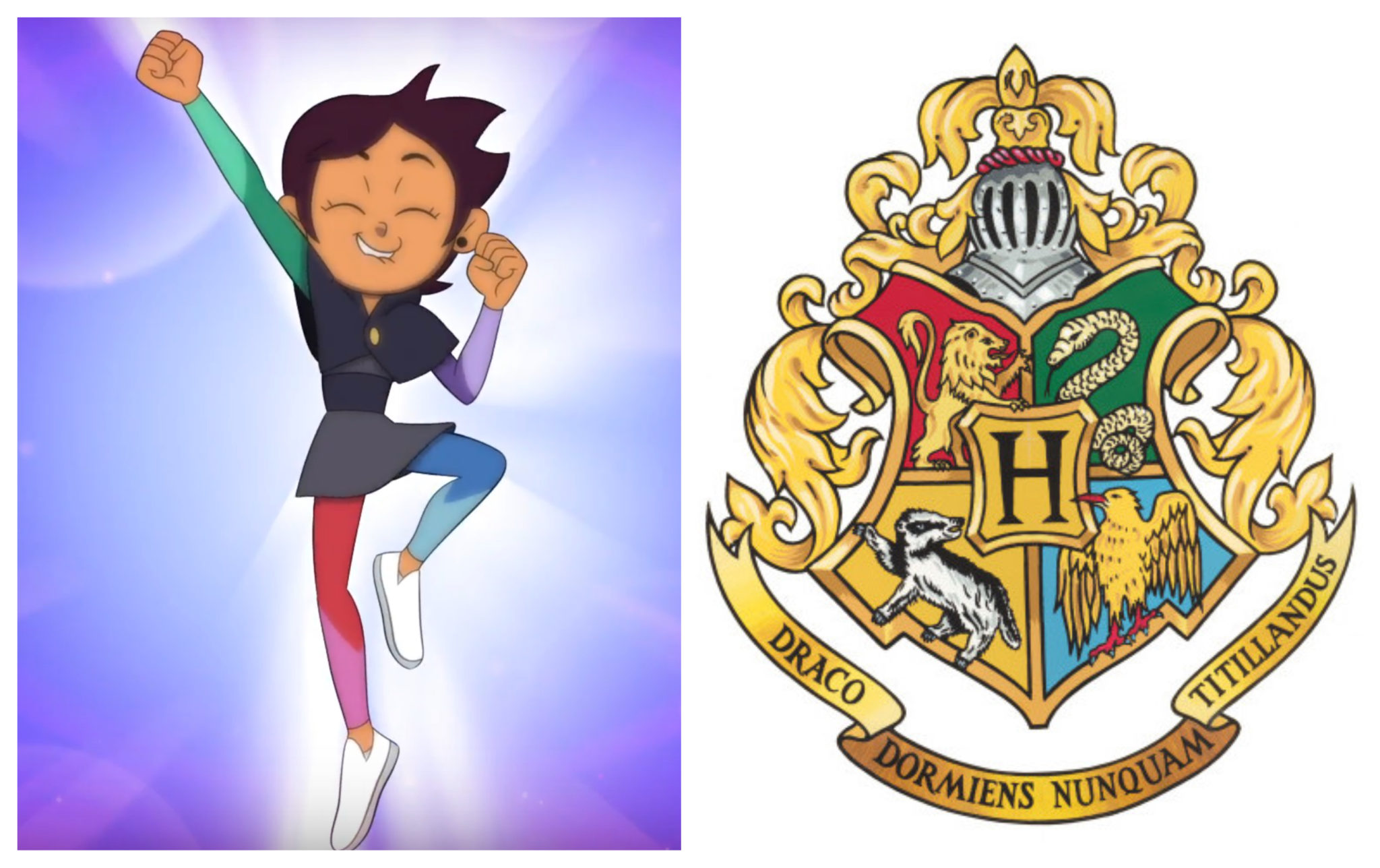
Luz’s uniform has only four main colors, and in my opinion, this quadrangle’s layout echoes Hogwarts’s four-colored coat of arms. Hexside shares three of Hogwarts’s colors (red, green, and blue) while shifting their arrangement. In regards to the fourth color, the animation swaps yellow out for purple — possibly in reference to lavender, a historically queer-associated color. But Terrace doesn’t stop there when it comes to her sapphic storytelling. It is through attending Hexside that Luz meets and later befriends bully-turned-ally Amity Blight. A canonically-confirmed teenaged lesbian who is given space to be an awkward dork around her crush like any straight girl would be around her boy.
The Owl House is a step forward for Disney in terms of representation. Luz is also Dominican-American and Disney Channel’s first lead bisexual character. Terrace confirmed Luz’s orientation off-screen, but the show people heavily queer-coded her character from the beginning, as Luz has expressed attraction to more than one gender. Bi pride colors are a motif as well. The narrative is clearly setting her up for an eventual love story with Amity, a recurring lesbian character. Terrace, an out bi woman, confirmed this set-up through social media posts and likes.
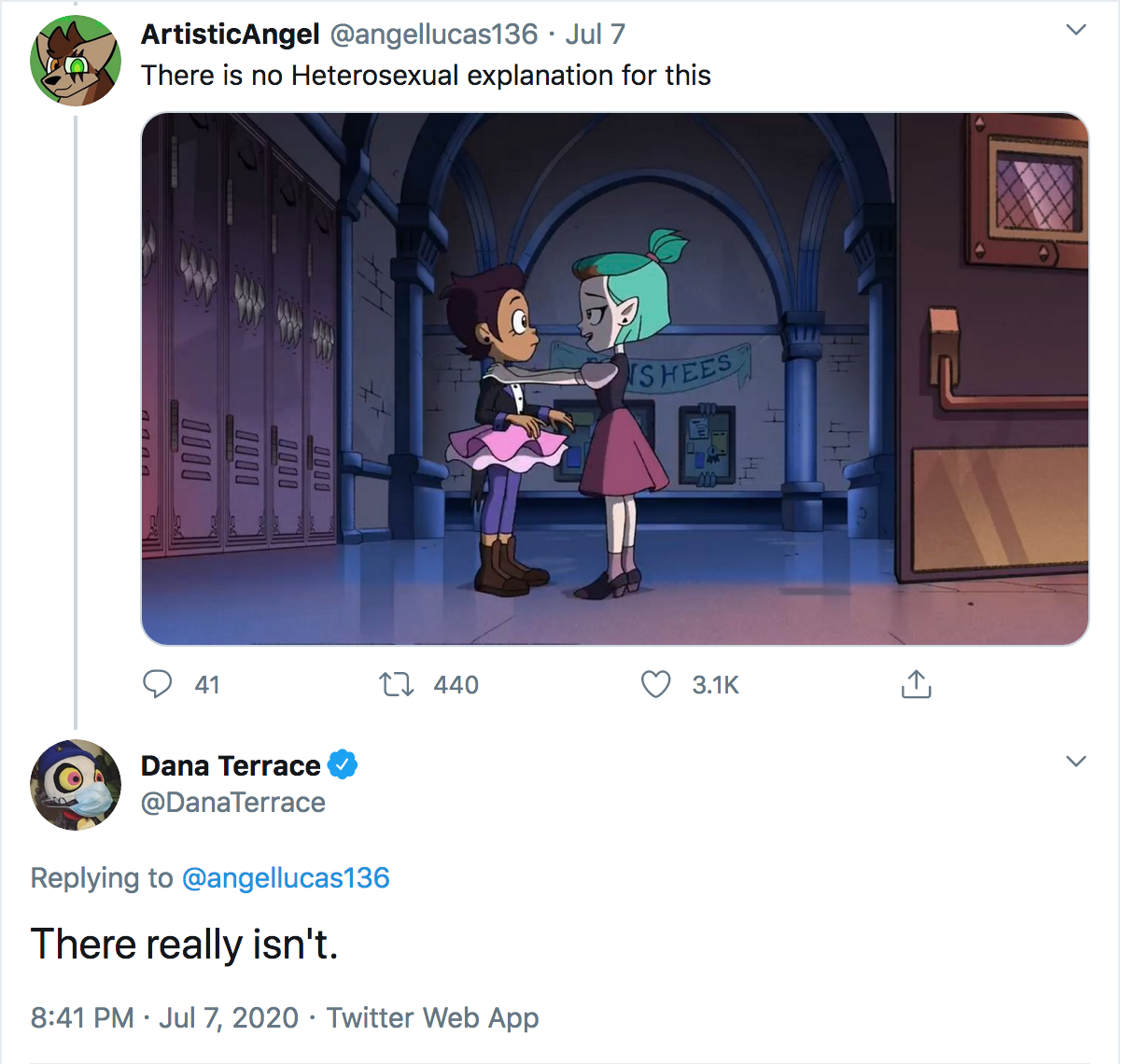
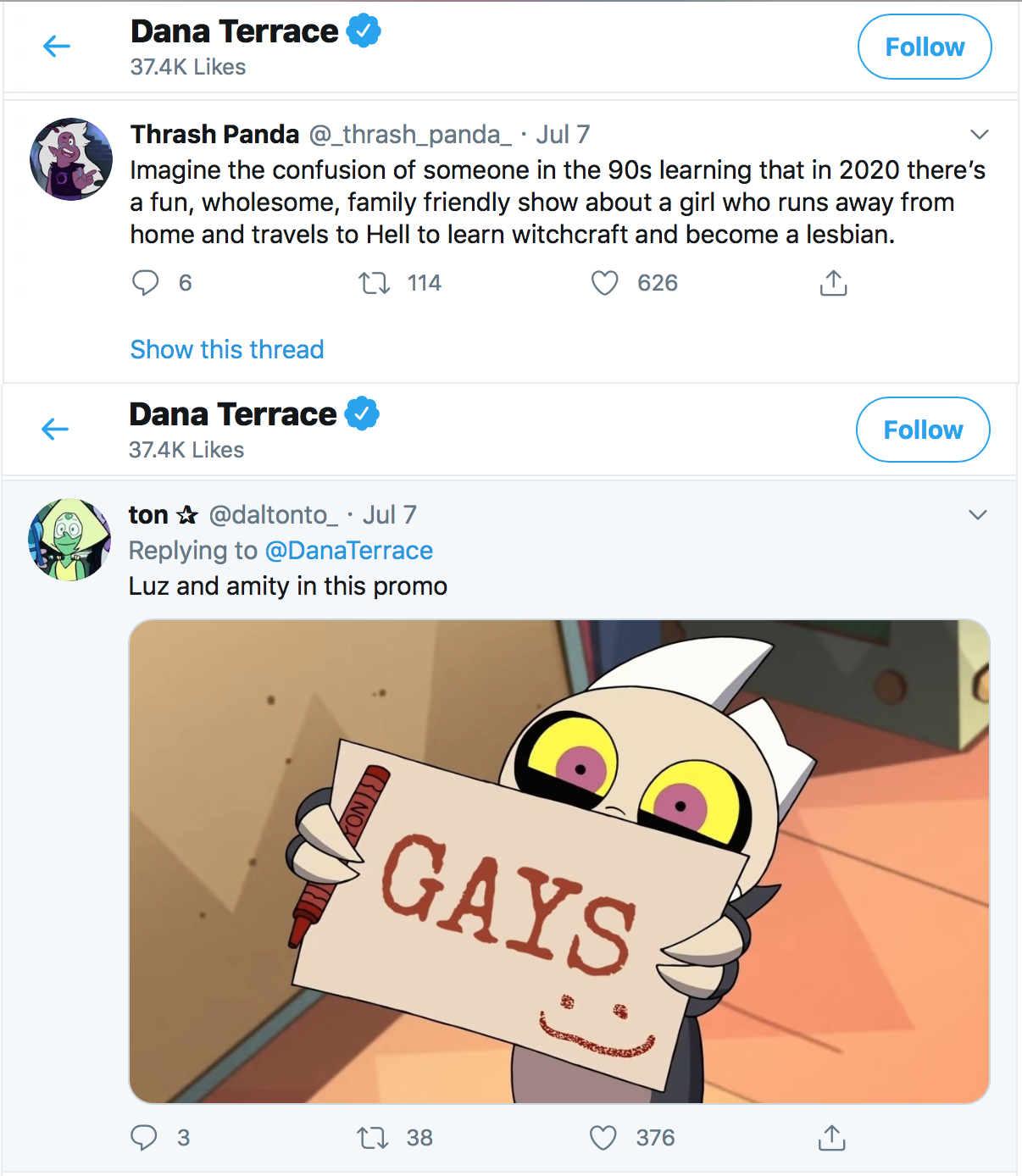
In regards to The Owl House and queer representation, I want to go over how the show people frame her romance in positive tropes.
Lumity in ‘Enchanting Grom Fright’:
The Luz/Amity relationship, or ‘Lumity’, as the fans dubbed it, deserves its own thinkpiece. But for the sake of this article and for my feelings I am focusing on one of the most overtly queer episodes, ‘Enchanting Grom Fright’. Terrace wrote the story with head writer Rachel Vine and writer Molly Ostertag, the latter also writing the teleplay. Ostertag, a gay woman, has also written and drawn queer stories for years, so it’s fair to say that this script got a big stamp of feminism and sapphism.
Episode 1×16 ‘Enchanting Grom Fright’ aired on August 8th to critical and fandom acclaim. Even before it aired, the episode generated buzz as the promo clips hinted at a prom-like storyline, and Terrace fueled the excitement with her Twitter activity. Then, some of the show people dressed up for the premiere, several of them out individuals. It was clearly a labor of love, this episode, and Terrace made clear that she was creating representation for the adolescence she didn’t get to have.
The episode centers around Hexside’s Grom Night and Luz’s budding friendship with Amity, as well as Luz’s relationship with her mother. In regards to Grom, the school’s dance isn’t just dance, but an annual party thrown over a death match. The nominated ‘Grom Queen’ has to fight a monster that lives under the school, and the monster, Grometheus, turns into whatever its opponent fears. Amity is this year’s Grom Queen. But Luz steps up to fight the monster in Amity’s place.
The writers position Lumity on parallel character arcs in ‘Enchanting Grom Fright’ as Luz and Amity come to face their deepest fears. Amity balks at being Grom Queen as she doesn’t want Grometheus to announce her intensely personal fear to the whole school; Luz fears her possible incompetence as a witch but can squelch that in order to help someone else. Their approach to Grom also reflects their emotional awareness. Amity knows her deepest fear. Throughout the episode, she carries a pink note in scenes that feature Luz. Viewers later learn that it’s a Grom invitation that she had been saving to give to Luz. Luz, on the other hand, is in denial. She comes to realize that her deepest fear relates to her mother. Luz fears the day she has to confront her mother about witchcraft. It’s not that she and her mom aren’t close. Luz is just avoiding her mother as she thinks Luz is away at summer camp, and so Luz has raised emotional barriers, ignoring her mother’s texts.
These differences also make sense in the context of Lumity as we see Amity sputtering the next episode, drowning in crush-dom, with Luz beautifully clueless to Amity’s feelings or to her own.
When the aforementioned Grom Night comes, Luz takes the monster on but has a breakdown when it transforms into her mother. Afraid of disappointing her, Luz runs away. The monster pursues her to a cliff, and before Eda can intervene, Amity arrives. Audiences watch as Grometheus turns into a shadowed figure that takes the note from Amity’s pocket and tears it in half, playing out her fears of rejection. The story slows down in this moment, giving room for vulnerability as Luz finds half of the note, realizing that Amity feared rejection. She offers to go to Grom with Amity as a friend, and Amity accepts. The girls then dance together, incorporating their magic into their moves, destroying Grometheus. In the monster’s place grows a pink-blossomed tree that bestows crowns on them. As a crowd of celebratory classmates carries Luz and Amity away, the audience sees the other half of the note, the invite reading: Luz, Will you go to prom with me?. The note confirms that Amity is queer, validating queer viewers and paving the way for the next episode, with Amity as the definition of Gay Panic.
The episode ends with Luz finally texting her mother back, opening up a little about her experiences, though still avoiding the whole ‘witch apprenticeship’ part. And the artists again paralleled Lumity, this time visually. Luz sits in her bedroom window, and so does Amity. ‘Enchanting Grom Fright’ is an episode about characters growing and growing towards one another, and Terrace’s crew achieved that beautifully.
The Witch and Her Maiden Fair:
‘Enchanting Grom fright’ pulls from the modern American tradition of prom, an event often seen as a rite of passage for fictional and nonfictional youths alike. The students dance to music reminiscent of mid-century rock like ‘Johnny B. Goode’, recalling for me Back to the Future’s prom scene and sock hops in general. This music reappears during the special end credits, and these credits feature a series of turning yearbook pages, revealing to the audience how the rest of Grom Night went. These scenes feature queer elements in dress and coupling. Eda the Owl Lady swaps out her standard dress for a suit cut in a masculine style. Two blushing boys dance together at Grom. One male-female couple features both students in suits. And all of this comes without explanation, because on the Boiling Isles, there appears to be no variation of queerphobia (like homophobia, transphobia, etc.). Then, after Grom tears Amity’s letter in two and crumples it up, the pieces fall to the ground and resemble rose heads. In my opinion, that image of two rose heads on the ground recalls the prom staple of corsage flowers.
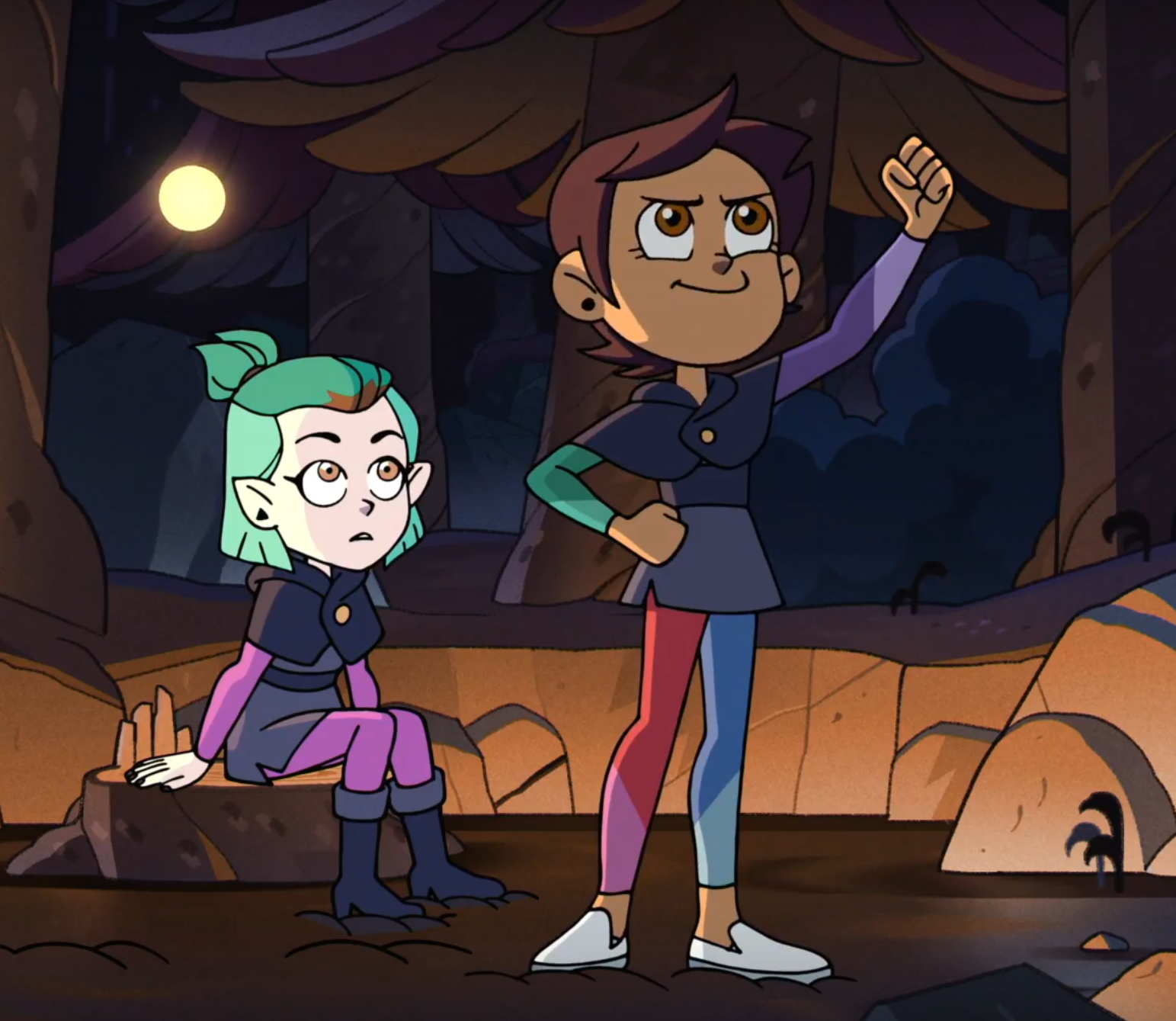
Similar to the show’s art style, the narrative set-up evokes fairytales and centuries-tested tropes. For starters, the monster’s name, Grometheus the Fear Bringer, recalls the mythological character ‘Prometheus’, the Titan who taught humans about fire. (It’s not the first time the show uses a name from Greek mythology.) The monster element then folds well into the narrative, as courtly love first comes to mind — medieval stories about honorable knights fighting in the name of towered maidens. Terrace figures Lumity into the knight-princess mold while modifying the archetype for modern times. Luz offering to fight in Amity’s place recalls the knight in service to the princess. After Luz makes her offer, she even declares, “I’ll be your fearless champion!” and strikes a knightly pose. Amity fits as the princess also because she comes from a wealthy family, growing up in a stately manor, and because of her place within Hexside’s hierarchy. She studied hard in order to become her coven track’s top student, and she socializes with the popular crowd, two of her friends from the same economic class.
In terms of gender expression, Lumity maps onto this trope as well — to a degree. While there is nothing wrong with masculine women, traditionally active character archetypes like the knight are androcentric. Masculinity still remains the default when we consider representations of agency. We need more representation of androgynous and feminine-presenting characters in active roles. The queerness of The Owl House makes room for this due to its respect for femininity and the female experience and attention to bisexuality.
Amity, the more femininely dressed of the pair in general, wears the dress and high heels to Grom. When Luz has a moment of doubt before Grom, Amity gives her a pep talk, praising her courage, as the female love interest emotionally nurtures the hero before battle. But this ‘damsel in distress’ character aids the hero in her time of need, and they defeat the monster together. Amity also makes the offer to dance, subverting the traditional femme role of social passivity.
Luz, on the other hand, resists strict gender expression both in her day-to-day wear and during Grom, especially the latter. Terrace and Co. present Luz through a bisexual gaze, blending gender signifiers. Bisexual culture has a long and proud history of androgyny and fluid gender expression, and Luz’s general character design lingers between androgynous and tomboy lite, yet she considers wearing a dress to Grom. She then settles on combining a tailcoat and a bright pink tutu, her hair slicked back like bicon James Dean. The pink tutu and purple tights make up two-thirds of the bi flag, representing her same-gender attraction and fluid queerness. A month before the episode dropped Terrace even liked a tweet about the bisexual implications of Luz’s Grom outfit.
When she gives Luz that pep talk, Amity compliments her outfit, saying “You look nice. Strange, but… nice.” That phrasing recalls, for me, how Luz straddles two worlds — Earth and the Boiling Isles, a seemingly impossible being as a human who figured out magic. Her duality and otherness then remind me, furthermore, of the Magical Bisexual trope that has developed on television in recent years. This trope manifests in magical characters whose fluid sexuality is an extension of their otherness, their status as aliens from another world. The Owl House twists this recent trend by having a normal human be the foreigner from a strange land, Luz’s Earthly ways mysterious to residents of the Boiling Isles. Luz is a normal girl in a magical world, yet the story still finds a way to fit her into queer, and specifically bisexual, culture — the tradition of bisexuality associated with inbetween-ness, with magic.
‘Enchanting Grom Fright’ also was satisfying as a queer prom storyline not only because of its queer-coded characters but because its openly queer creator and team members were hyping up that interpretation. On Twitter, Terrace even referred to the dance as ‘a fairy tale dance sequence’. That same day she tweeted about having to fight for bi and gay representation while the show was in development, stressing that her project is “VERY supported by current Disney leadership”. Such authenticity serves as secondary affirmation in a cinema culture that buries its Gays and queerbaits ships for clicks. In my last article, I mentioned the importance of the queer community, mentors, and public queer figures. They play a part in this too, the Elder Gays reassuring their young queer viewers that they can have a story with ‘happily ever after’ too.
Overall, The Owl House blends Americana and fantasy narratives and by doing so, it shows how queer youth can and do belong in the stories we tell. That they don’t just have to be dead or be villains but the heroes.
Good Representation Brings Up a Lot of Feels:
Speculative fiction — fantasy, science fiction, horror — is ideal for processing the horrible absurdity of abuse. Freud even acknowledged the link between childhood trauma and supernatural symbolism, how the fantastical provided language to describe the unspeakable. Similarly, a silence exists that queer people have to learn how to fill, learning how to reclaim and reshape culture so we can see ourselves. Bisexual erasure further compounds this silence as it happens from both sides.
So to see parts of myself in a fantasy story that grounded itself in a tradition that I’m usually locked out — as a woman, as a bisexual woman, as a survivor of trauma — means a lot. And receiving this sort of validation brings up — for me at least — what I think of as backdraft feelings. In the book Mindfulness-Oriented Interventions for Trauma, psychologists explain an emotional experience through metaphor:
“Backdraft occurs when a firefighter opens a door with a hot fire behind it. Oxygen rushes in, causing a burst of flame. Similarly, when the door of the heart is opened with compassion, intense pain can sometimes be released. Unconditional love reveals the conditions under which we were unloved in the past[.]” (p. 52)
I apply this “unconditional love” to good representation. Representation that feels fulfilling, it can stir up… feels. Because suddenly you know what society at large denied you growing up. Wondering what could have been, the painful poignancy of that inner child finally being validated. Ultimately, my complicated feelings about The Owl House stem from the pain of normalcy, of finally being included in the cultural scripts that marginalization denied you. And sometimes, finally seeing yourself does feel like having been burned.
When considering reclamation, YouTube channel Dreamsounds explained, “Being queer also means having a complicated relationship to culture and having to spend almost your entire life disentangling how your personal self-discovery has been hindered by stereotypes,” (t. 12:44-12:52). We grow up reading fairy tales and watching Disney movies, and then when we get to high school, we have to navigate prom culture. But the noble knight and steadfast princess are usually a heteronormative pairing rooted in patriarchal gender norms. And for many queer individuals, prom is an incomplete experience, because of being closeted, of delayed realizations.
For most of our experience with media, we have to find the cracks that can accommodate us. ‘Enchanting Grom Fright’ and The Owl House in general offer art that we don’t have to reframe in order to reflect us. These kinds of stories help us to create better futures because they show how we can fit into the mythologies and the histories of our past. And I look forward — no, need — season two.
Images courtesy of Disney Television Animation and the Wizarding World
Have strong thoughts about this piece you need to share? Or maybe there’s something else on your mind you’re wanting to talk about with fellow Fandomentals? Head on over to our Community server to join in the conversation!


